Photon detection
Researchers: M. Fujiwara, K. Tsujino, and M. Akiba
Collaboration with Z. Wang and S. Miki in Kobe Advanced ICT Research Center
Background
To identify the number of photons in a signal light pulse is an essential technology for any quantum information processing using photons. Unfortunately, however, it is still a challenging task in this field. A commonly used photodetector is an avalanche photodiode (APD) in which photo-electrons are amplified by cascading electron-hole pair generation, i.e. avalanche process, at the so called Geiger mode. Although such an APD can detect the arrival of photons, it fails to determine the precise number of photons arrived.
For the visible light region, the device is being developed at Stanford University from silicon, which is capable of identifying the number of photons of up to 2 or 3 per pulse. For the telecom-wavelength region around 1.5mm, a photon number resolving detector is being developed at NIST using a superconducting transition-edge sensor (TES) which is almost free from the main noise caused by dark currents. Its quantum efficiency has recently been improved to 80% with resonant cavities. However, the tungsten TES must be cooled to below 100 mK, and special readout technique such as a SQUID array amplifier is needed. Moreover, the TES has sensitivity for a wide range of wavelength. While this character is desirable for spectroscopy, it also means that it suffers from background radiation. So very tight radiation shield is necessary. These circumstances will hinder diffusion of the TES.
Advantage of superconducting single-photon detector in quantum key distribution experiments
The superconducting single-photon detector (SSPD) is based on a nanoscale superconducting wire that is biased close to its critical current Ic. A photon striking the wire forms a hot spot causing a transient voltage over the device that is registered as a photon detection. The SSPD has low detection efficiency 1%–20% but low dark count rates and ability to operate with sources producing photons at gigahertz speeds. Moreover, due to the low dark count rates and short dead times, the SSPD can be operated without gating electronics, while for the InGaAs APD, which makes it easy for implementing practical communication systems. SSPDs have been successfully employed in quantum key distribution QKD experiments, boosting both transmission distances and key generation rates rate. However, further improvements in device performance are highly desirable and will broaden the impact of SSPDs in QKD and other quantum information processing applications. In particular, significant effort is being put into increasing the detection efficiency DE and continuous photon counting rate.
Detail for SSPD





Ref: M. A. Jaspan, J. L. Habif, R. H. Hadfield, and S. W. Nam, APL 89, 031112 (2006) S. Miki, M. Fujiwara, M. Sasaki, B. Baek, A. J. Miller, R. H. Hadfield, S. W. Nam, and Z. Wang, APL 92. 06116 (2008) .


Recent results for telecom wavelength (November 2005).
We have demonstrated multiphoton discrimination at telecom wavelength with the readout frequency of 40 Hz by charge integration photon detector (CIPD). The CIPD consists of an InGaAs pin photodiode and a GaAs junction field effect transistor as a pre-amplifier in a charge integration circuit, which is cooled to 4.2 K to reduce thermal noise. The quantum efficiency of the CIPD (detector itself) is 80% for 1530 nm light, and the readout noise is measured as 0.26 electrons at 40 Hz. We can construct Poisson distributions of photo-carriers with distinguished peaks at each photo-carrier number corresponding to the signal to noise ratio of about 3.
Figure 1 shows the histograms of the measured photo-carriers distributions at a sampling of about 700 events with resolution of 0.1 electrons.
In Fig. 2, we show histograms of the photo-carrier number distribution with resolution of 1 electron for six kinds of pulse intensities. The histograms are in good agreement with systematic changes of the theoretical curves of Poisson distributions up to the number of 10.

Our scheme for telecom wavelength.
Our aim is to develop a photon number resolving detector with commercially available components. Our method is based on the use of an ordinary InGaAs pin photodiode and a low noise readout circuit using impedance conversion operating at the liquid Helium temperature of 4.2 K. An InGaAs pin photodiode has high quantum efficiency by itself. The main obstacle is to optimize the low noise readout circuit at 4.2 K so as to identify each electron-hole pair activated by a photon. Conventionally Si JFET has been used for a readout circuit at cryogenic temperature. This device, however, does not work well at 4.2 K due to the carrier freezing. Therefore we are using GaAs JFET instead and preparing a capacitive trans-impedance amplifier (CTIA) that can effectively detect minute electric currents. Figure 3 is a conceptual diagram of our scheme.

As seen, GaAs JFET shows good I-V characteristics and has big enough transimpedance. However, it produces discrete noises, which are called random telegraph signals (RTS), when it is used at the liquid helium temperature. These signals must be removed for our photon number resolving detector. We have found an effective method for this, called "thermal cure (TC)". That is, we are first to worm the device up to a certain temperature by passing electric current, and then cool it down to the cryogenic temperature while maintaining the electric current with an appropriate duty cycle. Please refer to the references for the details. We removed the majority of RTS using this process, and actualized a low noise level of 0.5 at 1 Hz. Figure 5 (a) shows the RTSs, and Figure 5 (b) shows the noise spectra with and without thermal cure treatment.
at 1 Hz. Figure 5 (a) shows the RTSs, and Figure 5 (b) shows the noise spectra with and without thermal cure treatment.


Thus we have developed a low noise readout circuit, and are now assembled to the photon detector. Theoretically, our photon number resolving detector can count the number of photons with a quantum efficiency of approximately 70% at the rate of up to 100 kHz. This speed limit is imposed by the noise characteristics. In fact, the noise spectrum of the GaAs JFET is characterized by 1/f noise up to 100 kHz. For higher frequency, the nose does not decease along with 1/f , but remains constant. So over this repetition rate the charge integration scheme will not work well to attain a high S/N ratio.
Our scheme for visible and near infrared wavelength

We present a charge integration photon counter (CIPD) toward photon-number resolving detector for the near-infrared wavelength band. In our scheme, photons are converted into electric carriers by a silicon avalanche photodiode (Si APD) operating in the linear mode instead of the Geiger mode. The reason is for reducing the large multiplication noise of Si APD to maintain the linearity in photon-electric conversion. In fact, some APDs have an almost noise-free multiplication process with very low gain (10.8) in the linear mode operation. Figure 1 shows the constructed probability distributions for the four kinds of the mean numbers of the input referred photoelectrons. The excess noise factor of this Si APD was 1.07, which was much smaller than those predicted by previous theory.

To read small number of photo-carriers generated by a Si APD in the linear mode, we used a charge integration readout circuit with a silicon junction field effect transistor (Si JFET). Figure 2 shows a scheme of our CIPD which consists of a charge integration readout circuit to amplify the photo-electrons generated by the Si APD, the so-called capacitive transimpedance amplifier (CTIA). The readout circuit noise corresponded to the standard deviation of 7 electrons, which was less than the multiplication factor of 10.8 times.

Although the signal-to-noise ratio of our CIPD is not enough to discriminate photon number at the near-infrared wavelength band, our CIPD attains ultra-low noise, and achieves the capability of photo-detection with the high linearity to incident light pulse intensity. Now, we try to improve the signal-to-noise ratio of our CIPD toward photon-number resolving detector.

